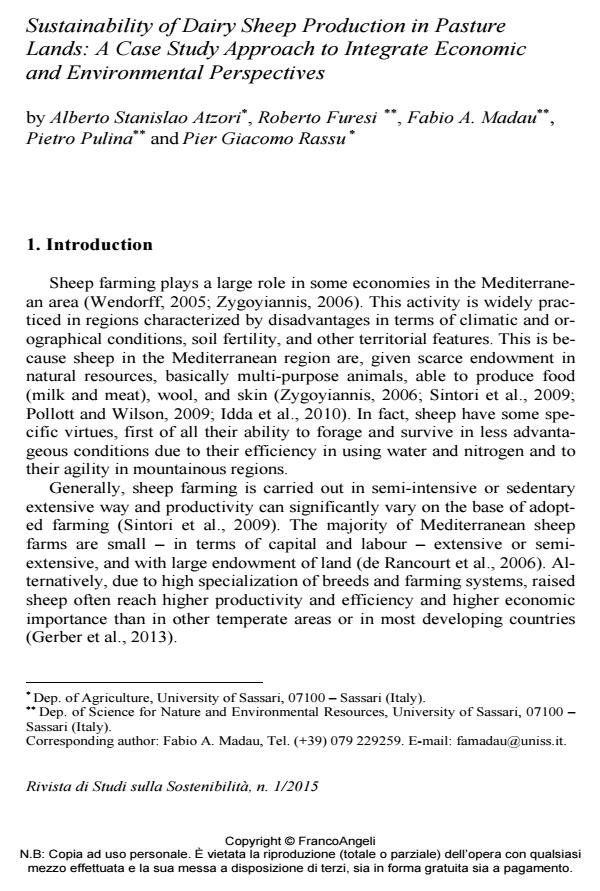Sustainability of Dairy Sheep Production in Pasture Lands: A Case Study Approach to Integrate Economic and Environmental Perspectives
Journal title RIVISTA DI STUDI SULLA SOSTENIBILITA'
Author/s Alberto Stanislao Atzori, Roberto Furesi, Fabio A. Madau, Pietro Pulina, Pier Giacomo Rassu
Publishing Year 2015 Issue 2015/1
Language English Pages 18 P. 117-134 File size 242 KB
DOI 10.3280/RISS2015-001008
DOI is like a bar code for intellectual property: to have more infomation
click here
Below, you can see the article first page
If you want to buy this article in PDF format, you can do it, following the instructions to buy download credits

FrancoAngeli is member of Publishers International Linking Association, Inc (PILA), a not-for-profit association which run the CrossRef service enabling links to and from online scholarly content.
Sheep farming plays a large role in some specific economies, maintains strong links with natural resources, and produces multiple functions in rural areas. Its sustainability has to deal with different purposes. This study aims to assess economic and environmental sustainability of extensive dairy sheep farming in Sardinia. A case study approach was adopted in order to directly collect farm data and to integrate assessments on more dimensions of sustainability. We found that farm is not profitable without support of public financial aids. Furthermore, production of nitrogen is under the normative limit and greenhouses gas emission intensity, allocated with economic criteria, was equal to 2,3 and 16,1 kg of CO2eq emitted per kg of produced milk and meat, respectively. Empirical evidences suggest the need to better take into account environmental externalities and into the farmer’s choices. A public financial support system expressively based on minimizing environmental externalities might force farmers to incentive eco-sustainable production and guarantee them profitability.
Keywords: Sheep farming, balance sheet analysis, Life Cycle Assessment, local natural resources, multifunctionality, agricultural policies
- Review of environmental performance of sheep farming using life cycle assessment Akul Bhatt, Bassim Abbassi, in Journal of Cleaner Production 126192/2021 pp.126192
DOI: 10.1016/j.jclepro.2021.126192 - The sustainability of small‐scale sheep and goat farming in a semi‐arid Mediterranean environment Giuseppe Timpanaro, Vera Teresa Foti, in Journal of Sustainable Agriculture and Environment e12111/2024
DOI: 10.1002/sae2.12111 - Dietary strategies of feral and domestic horses under varying grazing pressures: insights for Mediterranean forest management Araceli Gort-Esteve, Jordi Bartolomé Filella, Xènia Roselló Molinero, Ada Torra Burgués, Joan Lluís Riera, Ariadna Nieto-Espinet, in Agroforestry Systems 208/2025
DOI: 10.1007/s10457-025-01291-9 - Economic performance of agritourism: an analysis of farms located in a less favoured area in Italy Brunella Arru, Roberto Furesi, Fabio A. Madau, Pietro Pulina, in Agricultural and Food Economics 27/2021
DOI: 10.1186/s40100-021-00199-z - Life cycle impacts of sheep sector in Ontario, Canada Akul Bhatt, Bassim Abbassi, in The International Journal of Life Cycle Assessment /2022 pp.1283
DOI: 10.1007/s11367-022-02105-1 - Key practices affecting the environmental impact of Ewe milk in mixed farming systems Matteo Finocchi, Fabrizio Giuseppe Cella, Ricardo Villani, Alice Cappucci, Francesca Vichi, Giuseppe Conte, Alberto Mantino, Marcello Mele, in Cleaner Environmental Systems 100353/2025 pp.100353
DOI: 10.1016/j.cesys.2025.100353
Alberto Stanislao Atzori, Roberto Furesi, Fabio A. Madau, Pietro Pulina, Pier Giacomo Rassu, Sustainability of Dairy Sheep Production in Pasture Lands: A Case Study Approach to Integrate Economic and Environmental Perspectives in "RIVISTA DI STUDI SULLA SOSTENIBILITA'" 1/2015, pp 117-134, DOI: 10.3280/RISS2015-001008